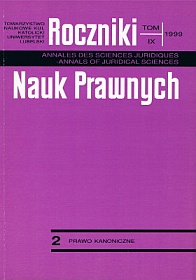A Repressive Character of the Polish Law In Application to the Catholic Church in the Years 1944-1956
Abstract
The totalitarian regime, introduced in Poland by the communist authorities after the Second World War, concerned a specific system of relationship between the state and the Church. In this system three factors were accumulated:
- the Muscovite-Byzantine caesaropapism characteristic of the supremacy of the state over the Church, a detailed supervision and interference of the state apparatus in the internal affairs of the Church;
2. ideological monism, tending to impose atheistic outlook on the whole society with the use of the state apparatus;
3. the Marxist conception of law as an instrument for the party-state apparatus to accomplish its own ideological ends.
The communists thought the Church to be the greatest opponent in the ideological battle. Therefore they used various repressions of political, economic and legal nature.
The first act of communists’ hostile policy towards the Catholic Church in Poland was the resolution of the Cabinet of September 12. 1945. The resolution breached the Concordat, thus violating the principles of the international law. In this manner it wrought a painful gap for the Church in the system of the Polish law. The communist authorities had gradually filled that gap with legal acts concerning particular spheres of its activity. All this was done to remove religion from the public life. deprive the Church of its entitlement and make its mission in society impossible.
The acts concerned the following spheres of life:
- the removal of religious elements form the public life, and in particular abolishment of the religious oath taken in state offices;
- secularization of family life (introducing obligatory civil marriages and the practice of divorces);
- the change of criminal regulations in order to establish the foundations for the repression of religious activity under the pretext of the protection of the freedom of conscience and religion;
- depriving church institutions of the property;
- liquidation of Catholic associations;
- nationalization of hospitals, institutions of social welfare, Caritas organizations;
- abolishment of church feasts;
- removing religion instruction front public schools, abolishing Catholic schools, and, in particular, limiting the activity of the Catholic University of Lublin;
- interfering in the process of the appointments at the church offices;
- establishment of some administrative organs established to fight against the Church.
This system of restrictions and repressions applied by the communist authorities against the Church was established in Poland in the years 1944-1945. It was a reception of the Soviet model of hostile separation. Contrary to what the communist authorities declared about the construction of a secular state, it was a religious state a rebours, in which religion was replaced with an official atheistic ideology.
Copyright (c) 1999 Roczniki Nauk Prawnych

This work is licensed under a Creative Commons Attribution-NonCommercial-NoDerivatives 4.0 International License.


